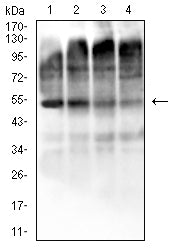
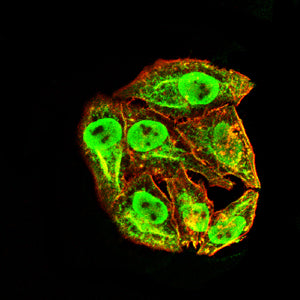
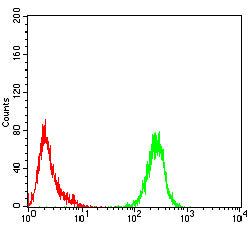
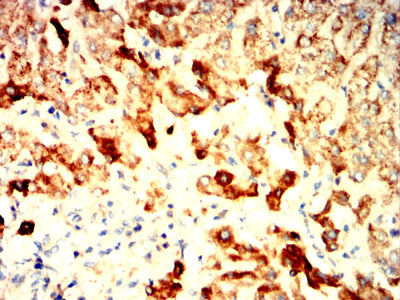
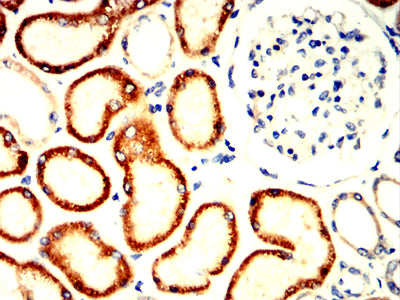
| WB | 1/500 - 1/2000 | Human,Mouse,Rat |
| IF | 咨询技术 | Human,Mouse,Rat |
| IHC | 1/200 - 1/1000 | Human,Mouse,Rat |
| ICC | 1/50 - 1/200 | Human,Mouse,Rat |
| FCM | 1/200 - 1/400 | Human,Mouse,Rat |
| Elisa | 咨询技术 | Human,Mouse,Rat |
| Aliases | EIF2B3;EIF-2B; EIF2Bgamma |
| Entrez GeneID | 8891 |
| clone | 1B9C12 |
| WB Predicted band size | 50.2kDa |
| Host/Isotype | Mouse IgG1 |
| Antibody Type | Primary antibody |
| Storage | Store at 4°C short term. Aliquot and store at -20°C long term. Avoid freeze/thaw cycles. |
| Species Reactivity | Human |
| Immunogen | Purified recombinant fragment of human EI2BG expressed in E. Coli. |
| Formulation | Purified antibody in PBS with 0.05% sodium azide |
+ +
以下是3篇与EIF2B抗体相关的参考文献(假设“EI2BG”为EIF2B的笔误,EIF2B是翻译起始因子相关蛋白复合物,与脑白质病变相关):
1. **文献名称**: *Mutations in EIF2B lead to impaired stress granule formation in vanishing white matter disease*
**作者**: van der Knaap MS et al.
**摘要**: 研究揭示了EIF2B基因突变通过干扰应激颗粒(stress granule)的形成导致儿童脑白质营养不良(VWM)的机制,并开发了特异性EIF2B抗体用于检测患者细胞中复合物功能异常。
2. **文献名称**: *Antibody-based profiling of EIF2B isoforms in neurodegenerative disorders*
**作者**: Pavitt GD, et al.
**摘要**: 开发了针对EIF2B不同亚基的单克隆抗体,用于分析神经退行性疾病患者脑组织中EIF2B复合物的表达变化,发现其与蛋白质翻译调控异常相关。
3. **文献名称**: *Targeting EIF2B mutations in cellular models of leukoencephalopathy using CRISPR and antibody validation*
**作者**: Wong K, et al.
**摘要**: 利用CRISPR技术构建EIF2B突变细胞模型,通过特异性抗体验证突变对复合物稳定性的影响,为药物筛选提供工具。
4. **文献名称**: *Autoantibodies against EIF2B in autoimmune encephalitis: a novel biomarker discovery*
**作者**: Zhang X, et al.
**摘要**: 首次报道了部分自身免疫性脑炎患者血清中存在抗EIF2B自身抗体,并通过ELISA和免疫组化验证其潜在诊断价值。
**注意**:若“EI2BG”为其他特定抗体名称,请提供更多背景信息以便修正检索结果。
The EI2BG antibody is a specialized immunoglobulin designed to target and bind the EI2BG antigen, a protein or epitope implicated in specific cellular processes. While detailed public information on EI2BG remains limited in widely accessible databases, antibodies of this type are typically developed to study protein expression, post-translational modifications, or signaling pathways in experimental models. Such antibodies are often raised in host species like rabbits or mice, utilizing recombinant protein fragments or synthetic peptides as immunogens to ensure specificity.
EI2BG likely plays a role in a niche biological context, such as a regulatory component in metabolic pathways, stress responses, or disease-related mechanisms (e.g., cancer, neurodegenerative disorders). Researchers might employ this antibody in techniques like Western blotting, immunohistochemistry, or immunofluorescence to localize the antigen within tissues or cells, quantify its expression under varying conditions, or assess interactions with other biomolecules.
Its development aligns with the broader goal of elucidating molecular mechanisms in targeted studies, potentially contributing to biomarker discovery or therapeutic target validation. As with many research-grade antibodies, validation data—including specificity, cross-reactivity, and optimal working concentrations—are critical for experimental reproducibility. Further characterization of EI2BG’s function and its antibody’s applications would enhance its utility in biomedical research.
×